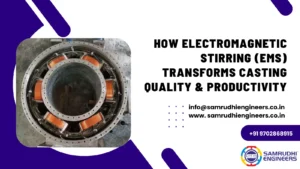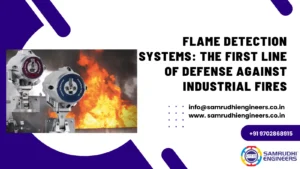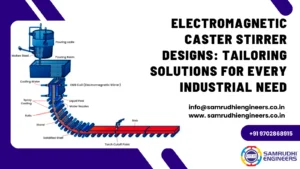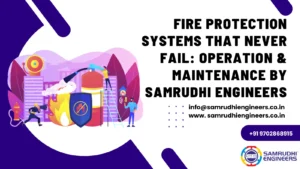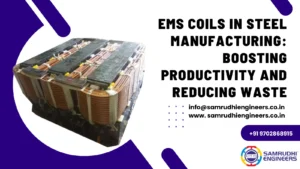In the metallurgical industry, stirring is a crucial process in ensuring the uniformity and quality of molten metal during various stages of production. Stirring methods can significantly influence the microstructure, mechanical properties, and overall quality of the final metal product. Two primary stirring techniques are commonly used: electromagnetic stirring (EMS) and conventional mechanical stirring. This blog delves into a comparative analysis of these two methods, examining their principles, advantages, and applications.
The Role of Stirring

Stirring in metallurgy serves several vital functions:
- Homogenization: It ensures uniform distribution of temperature, chemical composition, and solid inclusions within the molten metal.
- Degassing: Stirring helps in removing dissolved gases like hydrogen from the molten metal, which can cause porosity in the final product.
- Inclusion Removal: Proper stirring promotes the flotation of non-metallic inclusions to the surface, where they can be removed.
- Solidification Control: It aids in controlling the solidification structure, influencing grain size and distribution, which directly impacts the mechanical properties of the metal.
Conventional Stirring Methods
Conventional stirring methods in metallurgy generally involve mechanical means, such as impellers, rotors, or gas injection systems. These methods rely on physical contact or the introduction of a gas to create turbulence in the molten metal.
1. Mechanical Stirring
Mechanical stirring uses a rotating impeller or agitator submerged in the molten metal to create turbulence. The design and speed of the impeller, along with the viscosity of the molten metal, determine the effectiveness of the stirring.
Advantages:
- Simple and cost-effective setup.
- Direct control over stirring intensity by adjusting the speed of the impeller.
- Effective for small-scale operations and low-viscosity metals.
Disadvantages:
- Limited to certain types of metals due to wear and tear of the mechanical parts.
- Potential contamination of the melt due to erosion of the stirrer.
- Inconsistent stirring in high-viscosity melts or large volumes of metal.
- Difficulties in achieving uniform stirring in complex shapes or large containers.
2. Gas Stirring
Gas stirring involves injecting an inert gas, such as argon or nitrogen, into the molten metal through a porous plug or lance. The gas bubbles rise through the melt, creating turbulence and promoting mixing.
Advantages:
- Non-invasive method that avoids direct contact with the melt.
- Effective in degassing and inclusion removal.
- Applicable to a wide range of metals.
Disadvantages:
- Limited control over the intensity and uniformity of stirring.
- Potential for gas entrapment in the molten metal, leading to porosity in the final product.
- Less effective in highly viscous or high-density metals.
Electromagnetic Stirring (EMS)
Electromagnetic stirring (EMS) is a non-contact method that uses electromagnetic fields to induce motion in the molten metal. The principle behind EMS is based on the Lorentz force, which is generated when a conductor (the molten metal) moves through a magnetic field. This force creates a stirring motion in the metal, promoting homogenization and refining the microstructure.
Types of Electromagnetic Stirring
EMS can be applied at various stages of metal processing, including during melting, continuous casting, and solidification. There are different types of EMS based on the location and purpose:
- Mold EMS (MEMS): Used during continuous casting to control the flow of molten metal in the mold, reducing defects like segregation and improving surface quality.
- Strand EMS (SEMS): Applied during the solidification of the metal strand, enhancing the internal quality and grain structure.
- Final EMS (FEMS): Used in the final stages of solidification to refine the microstructure and improve mechanical properties.
Advantages of EMS
- Non-contact Process: EMS eliminates the risk of contamination and wear associated with mechanical stirring.
- Uniform Stirring: EMS provides a more uniform and controlled stirring effect, especially in large volumes of metal.
- Improved Microstructure: EMS refines the grain structure, reduces segregation, and enhances the mechanical properties of the metal.
- Energy Efficiency: EMS is more energy-efficient compared to mechanical stirring methods, as it reduces the need for reheating and allows for better temperature control.
- Versatility: EMS can be applied to a wide range of metals, including those that are difficult to stir mechanically, such as high-viscosity or high-density metals.
Comparative Analysis: EMS vs. Conventional Stirring
Efficiency and Effectiveness: EMS is generally more effective than conventional methods in achieving uniform stirring, especially in large volumes of molten metal or in metals with high viscosity. While mechanical and gas stirring can be effective in small-scale operations, they often struggle to provide the same level of control and uniformity as EMS.
Impact on Metal Quality: The non-contact nature of EMS significantly reduces the risk of contamination, leading to higher purity and quality in the final product. Additionally, EMS’s ability to refine the grain structure and reduce segregation results in improved mechanical properties, making it a preferred choice for high-performance applications.
Cost and Energy Considerations: While EMS has a higher initial cost, it often results in long-term savings due to its energy efficiency and reduced maintenance requirements. Conventional stirring methods, although cheaper to install, may incur higher operational costs over time due to wear and tear, energy consumption, and inconsistent results.
Application Flexibility: EMS offers greater flexibility in terms of application across different metals and stages of processing. Conventional methods may be limited by the type of metal being processed, the viscosity of the melt, and the scale of the operation.
Conclusion
The choice between electromagnetic stirring and conventional stirring methods ultimately depends on the specific requirements of the metallurgical process. EMS offers superior control, uniformity, and quality in most applications, making it ideal for large-scale and high-performance operations. However, conventional methods remain viable for smaller-scale or cost-sensitive operations where the benefits of EMS may not justify the higher initial investment.
As the metallurgical industry continues to evolve, the demand for higher quality and more efficient processes will likely drive the adoption of EMS in more applications. Nonetheless, understanding the strengths and limitations of each stirring method is crucial for optimizing metallurgical processes and achieving the desired metal properties.
Samrudhi Engineers has been at the forefront of metallurgical innovation, providing state-of-the-art electromagnetic stirring solutions tailored to meet the unique needs of various industries. With a commitment to quality, efficiency, and customer satisfaction, Samrudhi Engineers continues to play a pivotal role in advancing the adoption of EMS technology across the globe. Their expertise in both conventional and electromagnetic stirring systems makes them a trusted partner in optimizing metallurgical processes, ensuring that their clients achieve the highest standards of metal quality and performance.

